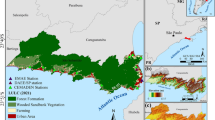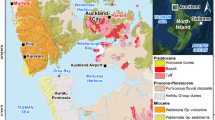Abstract
On July 13, 2004, heavy rainfalls because of the intensive activities of the rain front occurred in the Mid-Niigata Region, Japan. They were as much as 400 mm in 24 h, bringing about serious flooding by breaking the river banks. The heavy rainfalls also triggered more than 3,500 landslides. Three months later, the southern region of Mid-Niigata was attacked by an earthquake of magnitude 6.8 on the Richter scale on October 23, 2004. The main earthquakes were followed by intensive aftershocks, which continued until December 2004. By these earthquakes, variable landslides of more than 4,400 also occurred in the hilly and mountainous areas. Namely, different triggers brought about the variable landslides in the hilly mountains whose features are very similar in geological and geomorphological points of view. Therefore, these two events are very useful for clearing the difference in features of the landslides between the two. We have been researching on both landslides in the field just after both occurred and later analyzing air photographs using the geographic information system (GIS). In this paper, we describe the comparison in the distribution features using GIS analytical data between the heavy rainfall-induced and the intensive earthquake-induced landslides.

















Similar content being viewed by others
References
Active Fault Research Center, National Institute of Advanced Industrial Science and Technology (2004). Available at: http://www.gsj.jp/jishin/chuetsu1023/index.html
Hirata N, Sato H, Sakai, Sakai S, Kato A, Kurashimo E (2005) Fault system of the 2004 Mid Niigata Prefecture Earthquake and its aftershocks. Landslides 2:153–157
Iwahashi J, Sato HP, Yamagishi H (2006) The spatial distribution of shallow landslides caused by the Mid Niigata Prefecture Earthquake in 2004. J Geogr Survey Inst 110:81–89 (in Japanese; http://www.gsi.go.jp/REPORT/JIHO/vol110/9.pdf)
Kobayashi I, Tateishi M, Yoshioka T, Shimazu M (1991) Geology of the Nagaoka district. With Geological Sheet Map at 1:50,000. Geol. Surv. Japan, 132p (in Japanese with English abstract 6p)
Kobayashi I, Tateishi M, Uemura T (1993) Geology of the Izumozaki district. With Geological Sheet Map at 1:50,000. Geol. Surv. Japan, 91p, (in Japanese with English abstract 4p)
Sassa K (2005) Landslide triggered by the 2004 Mid-Niigata Prefecture earthquake in Japan. Landslides 2:135–142
Sato H, Sekiguchi T, Kojiroi R, Suzuki Y, Iida M (2005) Overlaying landslides distribution and topographical data:the Mid Niigata prefecture earthquake in 2004, Japan. Landslides 2:143–152
Sekiguchi H, Sato H (2006) Feature and distribution of landslides induced by the Mid Niigata Prefecture Earthqake in 2004, Japan. Landslides 43:142–154, (in Japanese with English abstract)
Suzuki Y, Niwa S, Taguchi M, Sekizaki K, Hasegawa M, Makoto I, Kadowaki T (2005) J Geogr Survey Inst 107:53–63, (in Japanese)
Ushiyama M (2004) Characteristics of heavy rainfall disasters in the Niigata Prefecture from July 12 to 13, 2004. Shizen Saigai Kagaku 23:293–302
Yamagishi H, Ayalew L (2005) Comparison between the landslides by heavy rainfalls on July 13, 2004, and Intensive Earthquakes on October 23, 2004, in Mid Niigata, Japan. In: Proceeding of International Symposium Landslide Hazard in Orogenic Zone from the Himalaya to Island Arcs in Asia. September 25–26, 2005, Kathmandu, Nepal, pp 83–91
Yamagishi H, Watanabe N, Ayalew L (2005) Heavy-rainfall induced landslides on July 13, 2004. In: Landslide Research Group of Landslide Society of Japan 7.13 Landslide Research Group of Niigata University Niigata K, Takara Y, Tachikawa and NMNS Bandara Nawarathna (eds) Monitoring, prediction and mitigation of water-related Disasters. MPMD, Japan, pp 501–506
Yanagisawa Y, Kobayashi I, Takeuchi K, Tateishi M, Chihara K, Kato H (1986) Geology of the Ojiya district. With Geological Sheet Map at 1:50,000. Geol. Surv. Japan, 177p (in Japanese with English abstract 6p)
Acknowledgment
We are grateful to Niigata Prefecture and Asia Air Survey, Asahi Koyo, and Naka-Nihon Air for providing air photographs and interpretation data, and thanks to Niigata University for providing funds for researching and getting much information. We thank also Dr. T. Komatsubara of the Geological Survey of Japan (GSJ) in Advanced Industrial Science and Technology (AIST) for providing us with digital data of the geological maps and useful comments on geological correlation. We are also grateful to Dr. K. Kawashima of the Research Center for Natural Hazards and Disaster Recovery, Niigata University, for providing useful precipitation data of many stations. Finally, we appreciate Dr. H. Ochiai for valuable reviewing.
Author information
Authors and Affiliations
Corresponding author
Rights and permissions
About this article
Cite this article
Yamagishi, H., Iwahashi, J. Comparison between the two triggered landslides in Mid-Niigata, Japan by July 13 heavy rainfall and October 23 intensive earthquakes in 2004. Landslides 4, 389–397 (2007). https://doi.org/10.1007/s10346-007-0093-0
Received:
Accepted:
Published:
Issue Date:
DOI: https://doi.org/10.1007/s10346-007-0093-0




